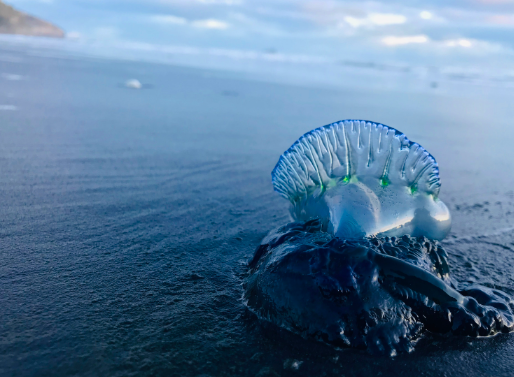What does a bad day look like? Touched by a Portuguese man o’ war

Have you ever been close to, or stung, by a Portuguese man o’ war?
While they can appear quite beautiful, the Portuguese man o’ war packs a horrific wallop if it touches you. No wonder they have the nickname of “Floating Terror.”
NOAA (National Oceanic and Atmospheric Administration) tells us, “The Portuguese man o’ war, (Physalia physalis) is often called a jellyfish, but is actually a species of siphonophore, a group of animals that are closely related to jellyfish. A siphonophore is unusual in that it is comprised of a colony of specialized, genetically identical individuals called zooids — clones — with various forms and functions, all working together as one. Each of the four specialized parts of a man o’ war is responsible for a specific task, such as floating, capturing prey, feeding, and reproduction. Found mostly in tropical and subtropical seas, men o’ war are propelled by winds and ocean currents alone, and sometimes float in legions of 1,000 or more!
“Resembling an 18th-century Portuguese warship under full sail, the man o’ war is recognized by its balloon-like float, which may be blue, violet, or pink and rises up to six inches above the waterline. Lurking below the float are long strands of tentacles and polyps that grow to an average of 10 meters (about 30 feet) and may extend by as much as 30 meters (about 100 feet). The tentacles contain stinging nematocysts, microscopic capsules loaded with coiled, barbed tubes that deliver venom capable of paralyzing and killing small fish and crustaceans. While the man o’ war’s sting is rarely deadly to people, it packs a painful punch and causes welts on exposed skin.
“Beachcombers, be warned: The stalwart man o’ war may still sting you even weeks after having washed ashore.”
Content source/credit: NOAA, “What is a Portuguese Man o’ War?”
CHOOSE TAPROOT® COURSES THAT BEST FIT YOUR TEAM’S NEEDS
For a complete overview of TapRooT® courses, please see our full selection of TapRooT® Root Cause Analysis Training courses.
We also offer on-site training for our clients and their employees.
Connect with us by phone (MAIN: 865.539.2139; SUPPORT: 865.357.0080) or email.
We offer ongoing support to our clients through free newsletters root cause tip videos, and the Root Cause Analysis blog on our website.
WHY IS TAPROOT® THE TOP RCA TRAINING?
TapRooT® has been designed for investigating seemingly simple problems that could have been worse (precursor incidents) by using a simple 5-step process. TapRooT® can also be used to investigate major accidents by using the complete 7-step process.
- The 2-Day TapRooT® Root Cause Analysis Course teaches the essential techniques for investigating precursor incidents and fixing them to prevent major accidents.
- The Equifactor® Training Course also teaches how to use the TapRooT® techniques and Equifactor® troubleshooting tables to stop equipment problems.
- The 5-Day TapRooT® Root Cause Analysis Team Leader Course teaches the complete 7-step TapRooT® process and techniques to investigate major accidents, serious environmental releases, fatalities, major plant upsets, and serious injuries.



